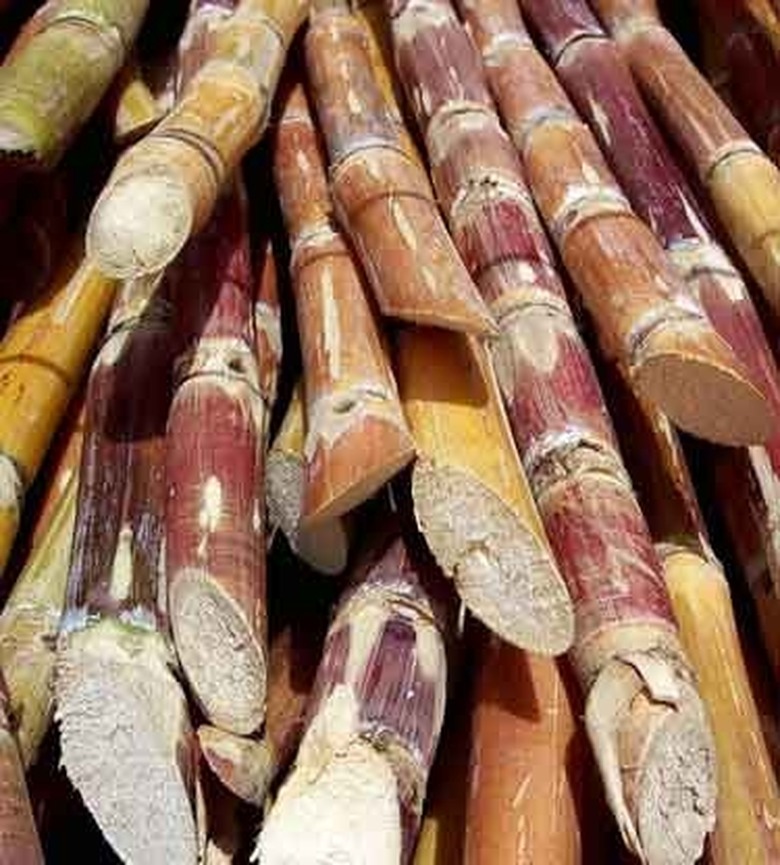What Is Sugar Cane?
Sugar cane is a subtropical/tropical grass that originated in Papua, New Guinea and spread throughout Southeast Asia, India, the Mediterranean, the Caribbean, Hawaii and the southern United States because of human migration and the slave trade. The migrations have also resulted in hybrid sugar cane plants. The juice from the sugar cane's stalk is highly prized and is the source of 70 percent of the world's sugar. It also has the highest number of calories per unit area of any plant.
Parts of a Sugar Cane
Parts of a Sugar Cane
Sugar cane is comprised of stalks, leaves and a root system. The stalk contains the juice used to make sugar and is broken up in segments called joints. Each joint has a node (band) and an internode (area between nodes). The leaves are attached to the node. The length and diameter of the joints and stalk vary by sugar cane species. The root system at the base of the plant anchors the grass to the soil and takes in water and nutrients from the ground. If the top part of the sugar cane is cut but the roots remain intact, the plant will regrow from where it was cut. It can take six to 24 months for the plant to grow to maturity.
Harvesting Sugar Cane
Harvesting Sugar Cane
Sugar cane is harvested when it reaches maturity and during the dry season of the particular sugar cane plantation. Harvest time can take anywhere from 2.5 months to 11 months. Harvesters (humans or machinery) chop down the stems and leave the roots to regrow for next season, collect the stems and load them onto a truck or rail wagon for transport to the processing facility.
Sugar Cane's Primary Use
Sugar Cane's Primary Use
Sugar cane is mainly used to make sugar. Because it is used to make 70 percent of the world's sugar supply, many sugar cane species have been bred to be high-yielding. In 2003, 289 million tons of sugar cane were produced in India alone.
Processing Sugar Cane into Sugar
Processing Sugar Cane into Sugar
Sugar cane juice is needed to make sugar. The juice is extracted in factories where larger rollers crush sugar cane stems. The juice is separated from the crushed stems for cleaning. Sugar makers clean the juice with slaked lime, which settles the dirt and other particles suspended in the juice. The clean juice is then boiled until it is a syrup. The syrup is then transferred to another pan, where the water is completely boiled to the point when sugar crystals can then grow. Once sugar crystals form, liquid/solid mix is spun to separate the two. The sugar crystals that are separated out are sticky and brown. These raw crystals are then dispatched to a refinery before being sold commercially. The leftover juice is sold as molasses.
Other Uses for Sugar Cane
Other Uses for Sugar Cane
Along with making sugar, sugar cane roots and stems are used to treat skin and urinary tract infections. One folk remedy combines sugar cane juice with dry ginger to stop hiccups, another uses equal parts sugar and yellow soap to treat boils. Sugar cane is also used to prepare a host of industrial chemicals as well as hair-removing products, skin exfoliators and soap. Lastly, it is used to make many alcoholic beverages, vinegars, cleaning solvents and paper.
References
Cite This Article
MLA
Fontelera, Jorina. "What Is Sugar Cane?" sciencing.com, https://www.sciencing.com/what-is-sugar-cane-12000127/. 21 July 2017.
APA
Fontelera, Jorina. (2017, July 21). What Is Sugar Cane?. sciencing.com. Retrieved from https://www.sciencing.com/what-is-sugar-cane-12000127/
Chicago
Fontelera, Jorina. What Is Sugar Cane? last modified March 24, 2022. https://www.sciencing.com/what-is-sugar-cane-12000127/
